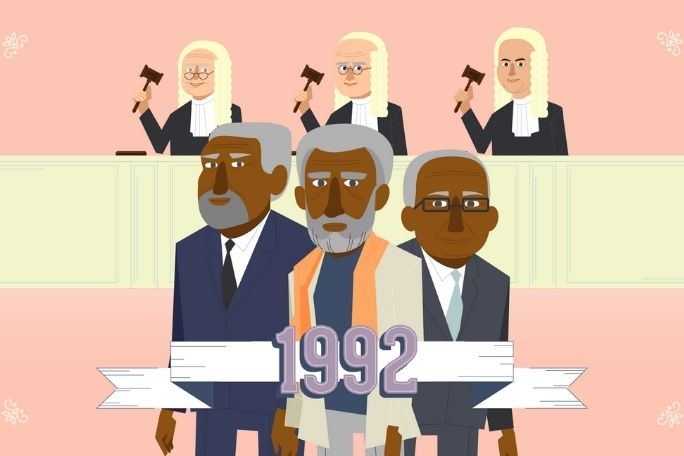Lesson summary
In this Finding Out lesson, students will read, watch, and analyse historical sources relating to Aboriginal and Torres Strait Islander peoples’ rights and freedoms. They will use visible thinking routines and scaffolded discussions to interpret and analyse each source. Students will engage in a Socratic Seminar to discuss the influence of Charles Perkins on Aboriginal and Torres Strait Islander peoples’ struggle for rights and freedoms, then deepen their historical understanding through independent research. Students will make connections between the National Apology to the Stolen Generations, progress in Aboriginal and Torres Strait Islander peoples’ struggle for rights and freedoms and reconciliation in Australia. They will research the events that prompted the apology, and communicate their understanding in an extended text. Students will reflect on their learning in this lesson by writing a paragraph explaining their understanding of the role that they play in ensuring that the rights and freedoms of others are not denied.
Essential questions:
- What are some of the historical events in Aboriginal and Torres Strait Islander peoples’ struggle for rights and freedoms?
- Who is Charles Perkins and what role has he played in the movement for Indigenous rights?
- What is the National Apology to the Stolen Generations and how is it related to reconciliation in Australia?
Lesson guides and printables
Curriculum links
Select your curriculum from the options below.
Lesson details
Curriculum mapping
(v9) Australian curriculum content descriptions
Year 10 History:
- The causes of First Nations Australians’ campaigns for rights and freedoms before 1965, such as discriminatory legislation and policies, the 1938 Day of Mourning and the Stolen Generations (AC9HH10K09)
- The significant events and methods in the movement for the civil rights of First Nations Australians and the extent to which they contributed to change (AC9HH10K11)
- The contributions of significant individuals and groups in the campaign for the recognition of the rights of First Nations Australians and the extent to which they brought change to Australian society (AC9HH10K10)
Syllabus outcomes: HT5-3, HT5-2.
General capabilities: Personal and Social Capability, Ethical Understanding, Intercultural Understanding.
Relevant parts of Year 10 achievement standards: Students explain the historical significance of the period between 1918 and the early 21st century. They explain the causes and effects of events, developments, turning points or movements in 20th-century Australia and internationally, leading up to and through the Second World War, and the post-war world. They describe social, cultural, economic and/or political aspects, including international developments, related to the changes and continuities in Australian society over this historical period. Students explain the role of significant ideas, individuals, groups and institutions connected to the developments of this period and their influences on Australian and global history.
Unit of work: Story of Our Rights and Freedoms – Year 10.
Time required: This lesson should be delivered over a series of four to five 60-120 minute sessions.
Level of teacher scaffolding: High – facilitate class discussion, student research and manage the sensitive nature of the content being delivered.
Resources required
- Student Worksheet – one copy per student
- Device capable of presenting a video to the class
- One web-enabled device per student for online research
- Chalk-Talk Visible Thinking Routine Prompts (enough copies for one between four students)
- Socratic seminar text: “Australia needs to be embarrassed, Perkins says” (one per student)
- Sticky-notes
- Butcher’s paper (optional)
Skills
This lesson is designed to build students’ competencies in the following skills:
- Collaboration
- Empathy
- Communication
- Cultural understanding
- Ethical understanding
- Problem solving
Additional info
Throughout the Story of Our Rights and Freedoms lessons, students will consider Civics and Citizenship concepts through a human rights lens. They will critically assess the Australian system of government and the effect that it has on our rights and freedoms.
There is no universally accepted definition of human rights, and our understanding is continually developing. Some definitions include:
- The recognition and respect of peoples’ dignity
- A set of moral and legal guidelines that promote and protect the recognition of our values, our identity and access to an adequate standard of living
- The basic standards by which we can identify and measure inequality and fairness
- Those rights associated with the Universal Declaration of Human Rights (UDHR)
When we talk about human rights we usually refer to principles that have been agreed upon by countries throughout the world. These rights have been set down in international agreements and form part of international law. They can also be written into the domestic law of individual countries. Human rights cover virtually every area of human life and activity. These include:
- Civil and political rights, such as freedom of speech and freedom from torture
- Economic and social rights, such as the rights to health and education
- Individual rights, including the right to a fair trial
- Collective rights, or those rights that apply to groups of people, such as the right to a healthy environment or to live on one’s ancestral land.
The UDHR is an international document that recognises the basic rights and fundamental freedoms to which all human beings are entitled. It was adopted by the United Nations General Assembly on 10 December 1948 and marks a key milestone in the history of human rights. The Magna Carta, though limited in who it protected, was an important precursor to the UDHR.
Click here to watch a video about the Magna Carta.
You can view the entire text of the Universal Declaration of Human Rights, and the other core international human rights treaties, on the United Nation’s website or by downloading RightsApp (free from the iTunes App store).


Welcome back!
Don't have an account yet?
Log in with:
Create your free Cool.org account.
Many of our resources are free, with an option to upgrade to Cool+ for premium content.
Already have an account?
Sign up with:
By signing up you accept Cool.org's Terms and Conditions(Opens in new tab) and Privacy Policy(Opens in new tab).